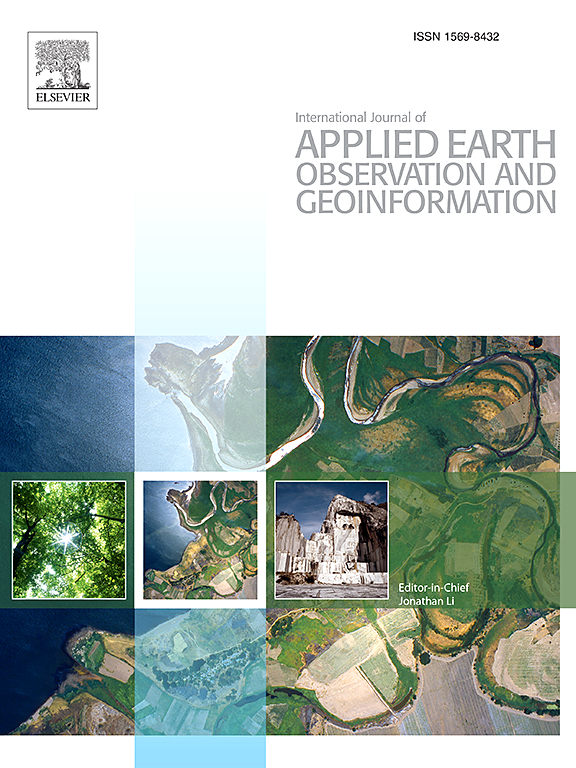在新发布的TanDEM-X 30 m DEM和DCM中集成多种地形特征进行伪影检测
IF 8.6
Q1 REMOTE SENSING
International journal of applied earth observation and geoinformation : ITC journal
Pub Date : 2025-06-04
DOI:10.1016/j.jag.2025.104632
引用次数: 0
摘要
2023年9月,德国航空航天中心(DLR)发布了TanDEM-X 30米编辑DEM (TDX30)和DEM变化图(DCM)。尽管改进的分辨率已经引起了科学界的兴趣,但在文献中,诸如不连续的地形表示、异常值和广泛的噪声等人工制品的存在仍然被低估。人造区域通常很小,但是这些区域内的地形分析结果基本上是不正确的,需要引起注意。此外,DLR提供的质量掩码不能准确反映伪影的程度。针对这一局限性,提出了一种融合多种地形特征的伪影检测框架。具体来说,选择了12个地形特征(包括坡度、粗糙度、二阶导数等)来区分伪像,并实现了CatBoost模型来检测伪像。该方法在黄土高原进行了试验。与预期相反,在黄土高原上,与TanDEM-X 90 m DEM (TDX90)相比,更高分辨率的TDX30导致人工面积增加了近80%(从195.84 km2增加到355.21 km2),突出了与分辨率提高相关的质量退化问题。而TDX30DCM(即dcm更新后的TDX30)的伪影面积减少至162.63 km2,显示出明显的抑制作用。人工产物与卫星观测几何形状之间的基本关系被确定:与南北斜坡相比,人工产物在东西斜坡上的出现频率明显更高,集中在35°~ 55°斜坡范围内,与TanDEM-X的极轨道和右侧观测模式相对应。验证结果表明,该方法在每个DEM上的检测准确率都很高:TDX90为96.84%,TDX30为98.44%,TDX30DCM为97.18%。本研究建立了一个可扩展的伪影检测框架,对促进全球DEM产品质量的提高具有重要的科学和实用价值。本文章由计算机程序翻译,如有差异,请以英文原文为准。
Integrating multiple terrain features for artefact detection in the newly released TanDEM-X 30 m DEM and DCM over the Loess Plateau
In September 2023, the German Aerospace Center (DLR) released the TanDEM-X 30 m Edited DEM (TDX30) and DEM Change Map (DCM). Although the improved resolution has garnered interest within the scientific community, the presence of artefacts—such as discontinuous terrain representation, abnormal values, and extensive noise—remains underreported in the literature. Artefact regions are typically small, but terrain analysis results within these regions are fundamentally incorrect, necessitating attention. Moreover, the quality mask provided by DLR cannot accurately reflect the extent of artefacts. To address this limitation, a novel artefact detection framework integrating multiple terrain features was proposed. Specifically, twelve terrain features (including slope, roughness, second-order derivatives, etc.) were selected for their ability to discriminate artefacts, and a CatBoost model is implemented for artefact detection. The proposed method was tested in the Loess Plateau. Contrary to expectations, over the Loess Plateau, the higher-resolution TDX30 resulted in a nearly 80 % increase in artefact areas compared to the TanDEM-X 90 m DEM (TDX90) (from 195.84 km2 to 355.21 km2), highlighting a quality degradation issue associated with resolution enhancement. However, the artefact area of TDX30DCM (i.e., DCM-updated TDX30) was reduced to 162.63 km2, demonstrating a significant suppressive effect. A fundamental relationship between artefacts and satellite observation geometry was identified: artefact occurrence frequency was notably higher on east–west slopes compared to north–south slopes, with concentrations in the 35°∼55° slope range, corresponding to TanDEM-X’s polar orbit and right-looking observation mode. Validation results demonstrated strong detection accuracy of the proposed method across each DEM: 96.84 % for TDX90, 98.44 % for TDX30, and 97.18 % for TDX30DCM. This study establishes a scalable artefact detection framework and offers significant scientific and practical value for facilizing the quality improvement of global DEM products.
求助全文
通过发布文献求助,成功后即可免费获取论文全文。
去求助
来源期刊

International journal of applied earth observation and geoinformation : ITC journal
Global and Planetary Change, Management, Monitoring, Policy and Law, Earth-Surface Processes, Computers in Earth Sciences
CiteScore
12.00
自引率
0.00%
发文量
0
审稿时长
77 days
期刊介绍:
The International Journal of Applied Earth Observation and Geoinformation publishes original papers that utilize earth observation data for natural resource and environmental inventory and management. These data primarily originate from remote sensing platforms, including satellites and aircraft, supplemented by surface and subsurface measurements. Addressing natural resources such as forests, agricultural land, soils, and water, as well as environmental concerns like biodiversity, land degradation, and hazards, the journal explores conceptual and data-driven approaches. It covers geoinformation themes like capturing, databasing, visualization, interpretation, data quality, and spatial uncertainty.
 求助内容:
求助内容: 应助结果提醒方式:
应助结果提醒方式:


